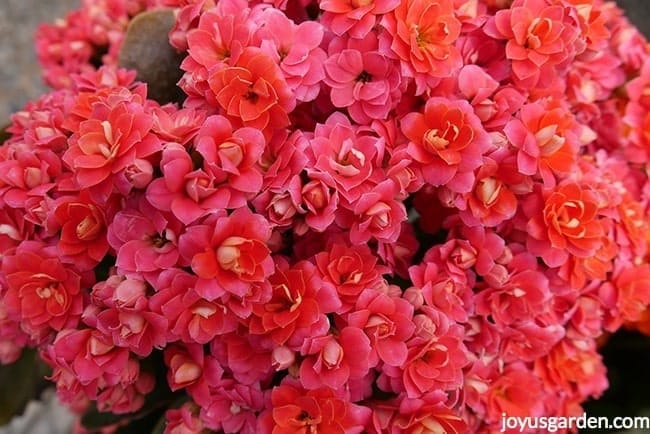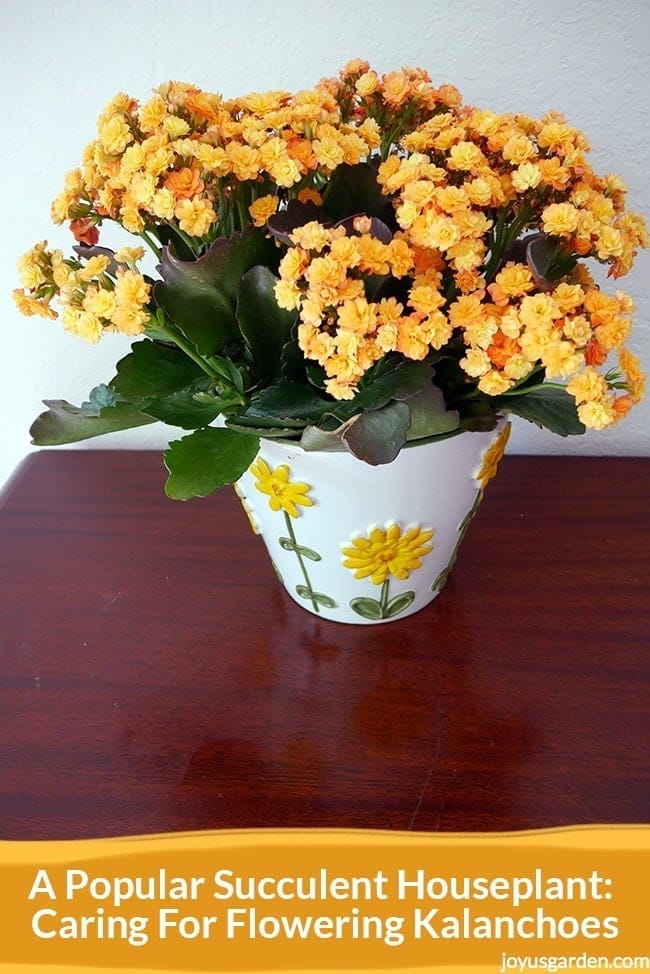Flowering Kalanchoes: How To Grow This Blooming Succulent
Kalanchoes are popular succulent houseplants with long-lasting blooms. Perhaps you’ve seen one but never brought it home. I want to encourage you to do that because they’re easy to grow and bloom for quite a long time. Here’s how to care for flowering kalanchoes and get them to bloom again.
Like most succulents, these are low-maintenance plants. This popular flowering succulent houseplant is very easy to find. It’s sold in grocery stores, nurseries, big box stores, garden shops, and flower shops.
They’re grown in a wide range of colors; most of them are vibrant hues like yellow, pink, magenta, orange, and red. No shrinking violets here! Around the holidays, you can more readily find them in white. The foliage makes a statement, too, because it’s glossy green, and the leaves are quite large.
- Botanical Name: Kalanchoe blossfeldiana
- Common Name: Flowering Kalanchoe, Flaming Katy, Florist’s Kalanchoe
Note: This post was originally published on 11/20/2017. It was updated on 8/19/2020 & 4/26/2024.
How to Care for Flowering Kalanchoes

These care tips are for keeping your indoor Kalanchoe going for the long haul. I had one for five years until it got too leggy, and I had to send it to the compost pile.
Calandiva and Grandiva are relatively newer cultivars (or varieties) with multi-petals that resemble roses now commonly sold in nurseries, Trader Joe’s, Home Depot, Lowes, etc. The Grandiva flowers are even bigger. Here is a guide dedicated to Calandiva Care.
Size
Kalanchoes sold in 6″ grow pots usually stand about 12″ tall. They’re also sold in 4″ pots and 2″ pots to go into dish gardens.
Exposure
Flowering Kalanchoes like bright, indirect light. A medium or high-light situation is best, provided they’re not getting direct sunlight. Be sure to keep them out of hot windows because they’ll burn.
The more light you give your Kalanchoe, the better it’ll look. In low light conditions, the flower buds tend not to open, and the foliage gets spindly. If you have low light and want a Kalanchoe, buy it in full bloom.
Yours would enjoy spending the summer outdoors just as long as it’s protected from the hot afternoon sun and excess rain. I live in the Arizona desert where I grow my Kalanchoes both indoors and out. I keep mine on the patio out of the sun completely because the rays are so strong, and the sun shines almost daily. They’d fry in full sun in a few minutes here in summer!
You might find this helpful: how much sun do succulents need.

How to Water Flowering Kalanchoes
These plants are succulents with fleshy leaves and stems (which store water), so you don’t want to keep them constantly wet. They need good drainage so the excess water can readily flow out.
Water yours, let all the water drain out, and then water again when the mix is dry. That might mean you water yours in a 6″ pot every two weeks. The frequency will vary depending on your temperatures, light situation, and the pot size/soil mix your Kalanchoes are in.
I water mine a bit more often when it’s flowering, and I water less often in the winter months.
They do best in pots with drainage holes. If your Kalanchoe comes wrapped in a pot cover, usually foil, or in a decorative pot with no drain hole, remove the plant when you water it. You don’t want water building up in the foil or a saucer because that will lead to root rot.
This could be a problem: Kalanchoes are subject to powdery mildew if kept too wet. The foliage is very dense and fleshy, so you don’t want to mist or spray this plant regularly.
You might find these posts helpful: a guide to watering indoor plants and how often to water succulents.
Fertilizing
I use a granular or liquid fertilizer. If you have a balanced organic houseplant fertilizer, you can use it in spring and summer if you think your plant needs it.
I use the same fertilizers for my kalanchoes as I do for my other houseplants. We have a long growing season here in Tucson, so I feed them once a month from the end of February through mid-November.
You don’t want to fertilize houseplants in late fall or winter because that’s their time for rest and they don’t need it.
Don’t over-fertilize your Kalanchoes. Salts build up and can burn the plant’s roots, causing brown spots on the leaves. Avoid fertilizing a stressed houseplant, one that is bone dry or soaking wet.
RELATED: Here’s my updated routine for fertilizing indoor plants.

Temperature/Humidity
Normal home temperatures are fine. As with any flowering plant, the hotter your home is, the faster the flowers will open up and the shorter the bloom period.
Regarding humidity, Kalanchoes are succulents and can handle the dry air in our homes just fine.
Pruning/Pinching
The foliage is so big and dense that I often remove some of it. The flower buds can be hidden beneath the leaves, so I prune out a few of them so that the flowers show more.
I grew many different types of kalanchoe plants in my Santa Barbara garden. There are over 200 species worldwide. Many of them tend to get leggy over time. You need to pinch them down after flowering to keep them fuller. Mine, as seen in the second photo below, has gotten wild. After flowering has stopped, I’m pruning it back by half.
Many Succulents Grow Long Stems and Kalanchoes aren’t an exception.


Propagating
You can propagate Kalanchoes by seed, division, leaf cuttings, or stem cuttings. I’ve never done it by seed, but that method takes the longest.
Division can be done easily if you divide the plant into two or three separate ones. Some have multiple plants in one pot, so it won’t be hard at all to divide them.
I’ve taken stem cuttings, about 4-5″ long, with the bottom leaves and a few leaves removed, and then healed them off (dry over at the ends) for a week or so. I planted them in succulent and cactus mix, and they started to root in about three weeks. Be sure not to mist the foliage while they’re rooting.
Both these methods are best done in spring, summer, or early fall. Avoid propagating a plant while it’s flowering.
Soil / Repotting
Succulent plants need to be in well-draining soil. When I repot my kalanchoes, I use half succulent and cactus mix and half potting soil. I also mix in a handful of compost/worm compost blend and sprinkle the top with a layer of that. You can use regular potting soil, but keeping it on the dry side is trickier, so I don’t recommend it.
Repotting is best done in spring, summer, and early fall like fertilizing and pruning.
Here’s a guide to repotting succulents you’ll find helpful.

Pests
I can’t remember my flowering kalanchoes ever getting any. They’re subject to aphids and mealybugs, so keep your eyes open for those critters. Spider mites could also be an issue. If you click the links, you’ll see what they look like and what can be done.
Catch them before they multiply. Houseplant pests can be hard to get a handle on if not controlled from the get-go.
Pet Safety
According to the ASPCA website, Kalanchoes are toxic to dogs and cats. You can check their website for more info on this subject and see in what way the plant is toxic. My kitty Tazzy has no interest in this plant and would much rather munch on a crunchy Spider Plant instead (that one is non-toxic, by the way).
Here’s are posts on pet-friendly houseplants as well as a video on 10 cat-friendly indoor plants.


Flowering / How To Make Kalanchoes Flower
This plant is so popular because of its masses of colorful flowers. Their bloom time is long, around eight to ten weeks. The foliage is so big and dense that sometimes I remove a bit of it so the flowers can easily open and show more.
By cutting the flower stems back, yours may naturally flower again in late winter or early spring.
If yours isn’t reblooming, you can try forcing it. Kalanchoes are photoperiodic (like Poinsettias and Christmas Cactus), which means they react to equal light and dark exposure periods. They need 12-14 hours of darkness to bloom again.
Chances are, if you have them in your home, they’re in a room that doesn’t get much complete darkness. You have to put them in a closet at night or cover them with a box and put them in a room with good light during the day.
And yes, they need those long nights for 6 to 8 weeks. Be sure to cut back on the watering during this time. Once the rest period is over and the buds begin to set, you can return them to their normal routine.
My current house has lots of natural light. My kalanchoe grows in a bright guest room during the day that’s completely dark at night. It came into bloom in early April, and new buds are appearing on every stem.
Video Guide
Note: I’ve also done a post on Calandiva care.
Kalanchoe flowers are long-lasting, and the thick, waxy leaves are rich, shiny green. They come in so many colors that you can surely find one you love. They’re a great blooming plant to brighten up your home!
Happy gardening,

This post may contain affiliate links, you can read our policies here.
- About the Author
- Latest Posts
Nell, the founder of Joy Us garden, was born into a gardening family and grew up in Connecticut’s countryside. After living in Boston, New York, San Francisco, & Santa Barbara, she now calls the Arizona desert home. She studied horticulture & garden design, working in the field all her life. Nell is a gardener, designer, blogger, Youtube creator, & author. She’s been gardening for a very long time & wants to share what she’s learned with you.











Hi Nell, I have a small plant in 6 inch pot. Would it be enough to cover it overnight with a bucket to get it to flower or must it be absolute, pitch dark? Also, when should this be done? I wouldn’t want to mess up it’s natural rhythms. Mine was given to me in December in flower -which can’t be natural. Enjoying your posts and videos, thanks.
Al – Thank you. I believe they naturally flower from fall through early spring. The growers do that procedure to get them to bloom all year. They need total darkness but the pail should keep it dark enough. Nell
Hi, mine just got some sort of spines or thorns and Im not sure if thats normal. I could send you some pics.
I’ve never seen that on this plant. Nell
Neil,
I was given a flower pot, which contained a Kalanchoe. I repotted it and now it is very bushy with no flowers.
Can I bring it indoors and start managing the light at 50/50 sunny/complete darkness?
Hi Sheila – You can bring it indoors if you’d like. Sometimes they do a light re-bloom on their own. You might want to wait until late Oct. when the evenings are typically longer. Nell